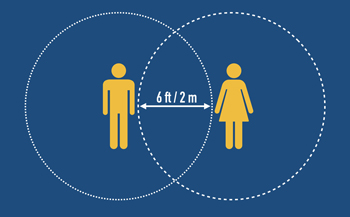By now we all know what a distance of 2 metres looks like. It's been painted on pavements across the country and illustrated using broom sticks and very tall people. But are 2 metres really enough to keep you safe from catching the infection from someone else? What if you can't stay that far away from others because you are on a train or in a shop? And what if you're in an air conditioned room where the air you breathe is continually moving around?

To answer these questions you need to know a lot about the flow of air and the movements of particles within it — you need to be a fluid dynamicist. "We build mathematical models of [the motion] of airborne materials which allow us to predict concentrations [of the material] at distances away from a source," explains Paul Linden, a fluid dynamicist at the University of Cambridge. "Mathematicians can also model how people move and calculate the statistics of the intersections of exhale and inhale breaths."
Armed with their mathematical models of air flow and particle transport, and with statistical techniques, fluid dynamicists are ideally placed to calculate what distance is safe and how to minimise the risk of infection. This is why Linden, along with other researchers and technical staff at the Department for Applied Mathematics and Theoretical Physics at Cambridge, have put aside their usual research to follow a call by the Royal Society to provide Rapid Assistance in Modelling the Pandemic (RAMP). Together with Chris Pain from Imperial College London, Linden leads a RAMP project comprising researchers in fluid mechanics who have volunteered their time and have expertise in a range of sub-areas, from the airborne transport of particles and droplets, to the ventilation of buildings and the evaporation of aerosols.
Providing rapid assistance
"There are two main purposes [of the project]: one is to quickly get a handle on what is known in [the various areas] and the other is to undertake long term research projects on questions that emerge from this initial review," says Linden. "Ideally we would like to come up with recommendations on how to ventilate buildings so that you minimise the risk of spreading the infection if someone in the building is infected."
See here for all our coverage of the COVID-19 pandemic.
In particular the project will address the kind of questions many of us will already have pondered ourselves. Where does someone's exhaled breath go as they walk between high shelves in a supermarket? How do droplets containing the virus deposit on surfaces and what's the risk of picking one up? And, in the light of the tragic death toll among bus drivers, what happens on public transport?
"The answers to such questions are still pretty unclear," says Linden. "There have been studies of the airborne spread of influenza, but they are limited. We would like eventually to provide some assessment of, for example, the risk of walking past someone in a supermarket — I think it's probably a small risk but it is important to back this up with some proper evidence one way or the other."
Performing experiments
The mathematical models that will provide the answers to such questions need to be informed by experiments, which are hard to perform during a lockdown. But Linden and Pain have already been in discussions with a large supermarket chain and a large public transport network with a view of doing case studies on location. And as of last week Linden and postdoctoral researcher Rajesh Bhagat have been allowed back into the fluid dynamics lab at the Department for Applied Mathematics and Theoretical Physics in Cambridge to get experiments rolling.
The project is still in the early stages: the first video call between its participants only took place very recently. But the hope is that the concerted effort of experts will soon lead to tangible results. "RAMP shows how many people are interested in helping on a voluntary basis and giving up their resources to do so," says Linden. Whatever the output, results are also likely to be useful in a (hopefully) post pandemic world. "[Such research] often leads to new insights into things that you never imagined before — so it's probably a win-win."